Introduction to Business Studies: HR, Finance, and Collaboration
VerifiedAdded on 2023/01/13
|8
|2003
|100
Report
AI Summary
This report provides a comprehensive overview of key concepts in business studies. It begins with an introduction to the subject, followed by an in-depth analysis of the roles of Human Resources (HR), Finance, and Marketing within an organization. The report details the responsibilities of HR in recruitment, training, and maintaining a healthy work environment; the importance of finance in cash flow management, profit planning, and control; and the role of marketing in differentiation and customer communication. Furthermore, it explores the concept of collaborative working practices, highlighting their benefits such as pooling of strengths, skill development, and faster solutions. The report also delves into the role of financial management, including financial planning and cash flow management, and the significance of financial reporting in providing information, control, and achieving overall organizational objectives. The report concludes by emphasizing the interconnectedness of these functions in achieving organizational goals.
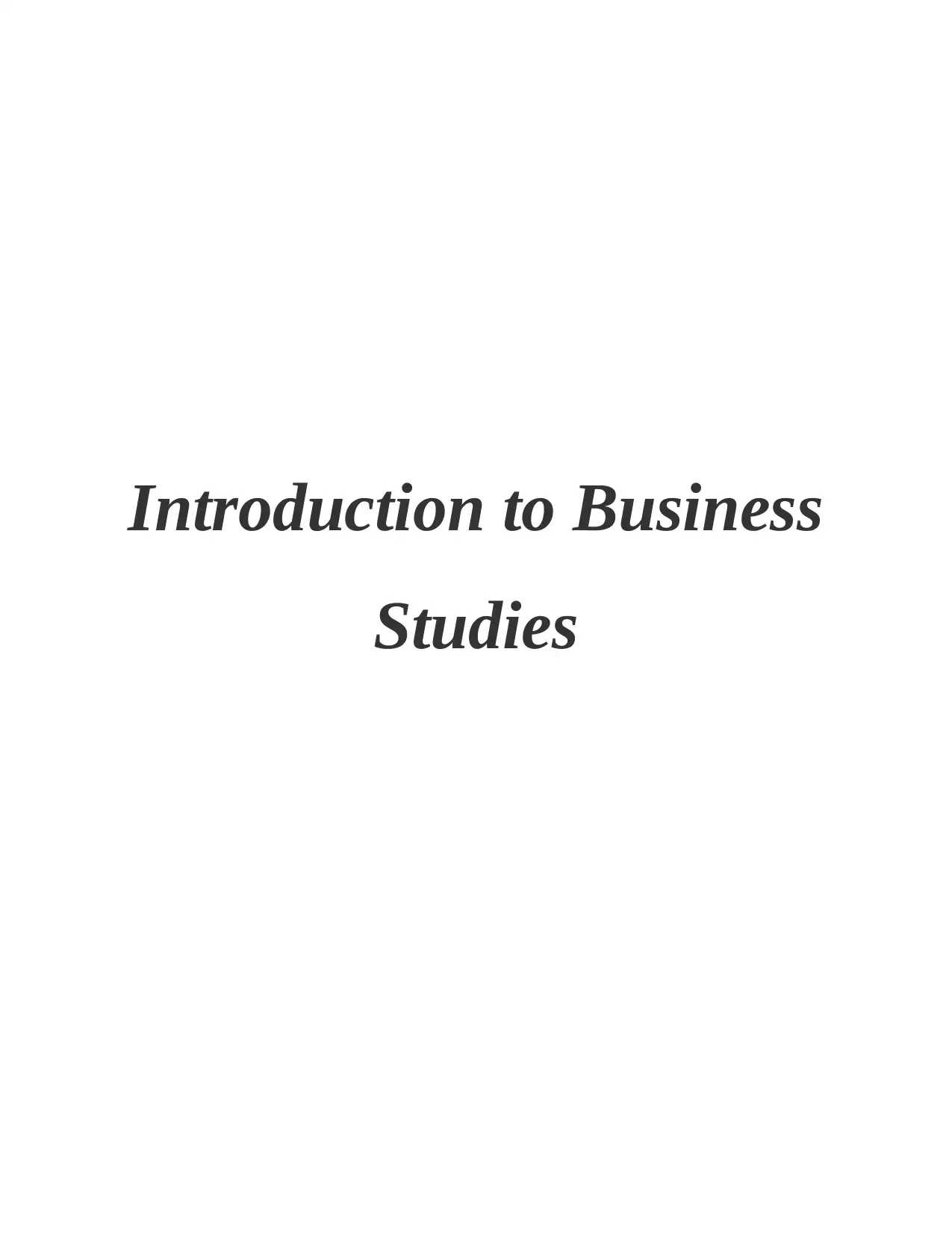
Introduction to Business
Studies
Studies
Paraphrase This Document
Need a fresh take? Get an instant paraphrase of this document with our AI Paraphraser
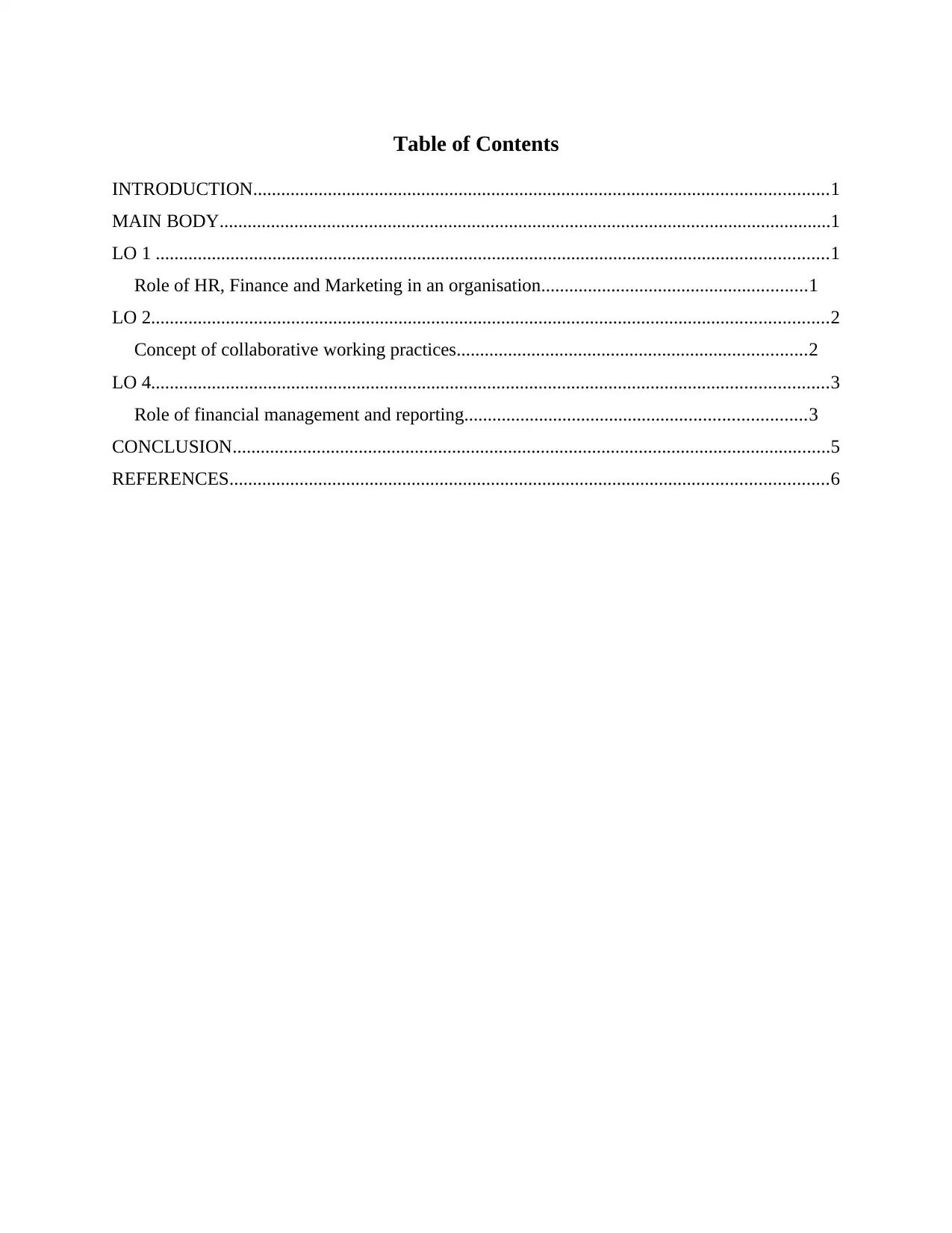
Table of Contents
INTRODUCTION...........................................................................................................................1
MAIN BODY...................................................................................................................................1
LO 1 ................................................................................................................................................1
Role of HR, Finance and Marketing in an organisation.........................................................1
LO 2.................................................................................................................................................2
Concept of collaborative working practices...........................................................................2
LO 4.................................................................................................................................................3
Role of financial management and reporting.........................................................................3
CONCLUSION................................................................................................................................5
REFERENCES................................................................................................................................6
INTRODUCTION...........................................................................................................................1
MAIN BODY...................................................................................................................................1
LO 1 ................................................................................................................................................1
Role of HR, Finance and Marketing in an organisation.........................................................1
LO 2.................................................................................................................................................2
Concept of collaborative working practices...........................................................................2
LO 4.................................................................................................................................................3
Role of financial management and reporting.........................................................................3
CONCLUSION................................................................................................................................5
REFERENCES................................................................................................................................6
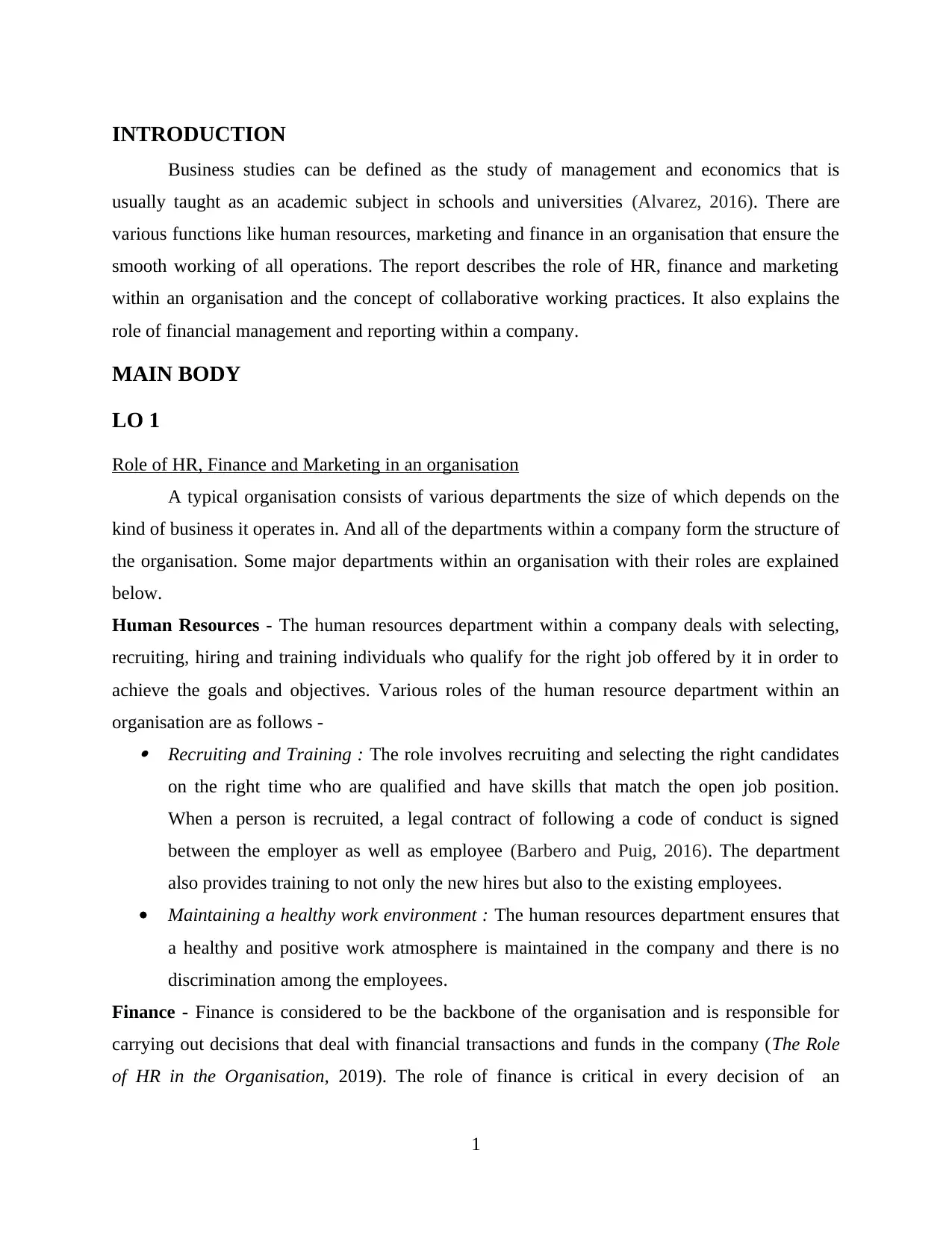
INTRODUCTION
Business studies can be defined as the study of management and economics that is
usually taught as an academic subject in schools and universities (Alvarez, 2016). There are
various functions like human resources, marketing and finance in an organisation that ensure the
smooth working of all operations. The report describes the role of HR, finance and marketing
within an organisation and the concept of collaborative working practices. It also explains the
role of financial management and reporting within a company.
MAIN BODY
LO 1
Role of HR, Finance and Marketing in an organisation
A typical organisation consists of various departments the size of which depends on the
kind of business it operates in. And all of the departments within a company form the structure of
the organisation. Some major departments within an organisation with their roles are explained
below.
Human Resources - The human resources department within a company deals with selecting,
recruiting, hiring and training individuals who qualify for the right job offered by it in order to
achieve the goals and objectives. Various roles of the human resource department within an
organisation are as follows - Recruiting and Training : The role involves recruiting and selecting the right candidates
on the right time who are qualified and have skills that match the open job position.
When a person is recruited, a legal contract of following a code of conduct is signed
between the employer as well as employee (Barbero and Puig, 2016). The department
also provides training to not only the new hires but also to the existing employees.
Maintaining a healthy work environment : The human resources department ensures that
a healthy and positive work atmosphere is maintained in the company and there is no
discrimination among the employees.
Finance - Finance is considered to be the backbone of the organisation and is responsible for
carrying out decisions that deal with financial transactions and funds in the company (The Role
of HR in the Organisation, 2019). The role of finance is critical in every decision of an
1
Business studies can be defined as the study of management and economics that is
usually taught as an academic subject in schools and universities (Alvarez, 2016). There are
various functions like human resources, marketing and finance in an organisation that ensure the
smooth working of all operations. The report describes the role of HR, finance and marketing
within an organisation and the concept of collaborative working practices. It also explains the
role of financial management and reporting within a company.
MAIN BODY
LO 1
Role of HR, Finance and Marketing in an organisation
A typical organisation consists of various departments the size of which depends on the
kind of business it operates in. And all of the departments within a company form the structure of
the organisation. Some major departments within an organisation with their roles are explained
below.
Human Resources - The human resources department within a company deals with selecting,
recruiting, hiring and training individuals who qualify for the right job offered by it in order to
achieve the goals and objectives. Various roles of the human resource department within an
organisation are as follows - Recruiting and Training : The role involves recruiting and selecting the right candidates
on the right time who are qualified and have skills that match the open job position.
When a person is recruited, a legal contract of following a code of conduct is signed
between the employer as well as employee (Barbero and Puig, 2016). The department
also provides training to not only the new hires but also to the existing employees.
Maintaining a healthy work environment : The human resources department ensures that
a healthy and positive work atmosphere is maintained in the company and there is no
discrimination among the employees.
Finance - Finance is considered to be the backbone of the organisation and is responsible for
carrying out decisions that deal with financial transactions and funds in the company (The Role
of HR in the Organisation, 2019). The role of finance is critical in every decision of an
1
⊘ This is a preview!⊘
Do you want full access?
Subscribe today to unlock all pages.

Trusted by 1+ million students worldwide
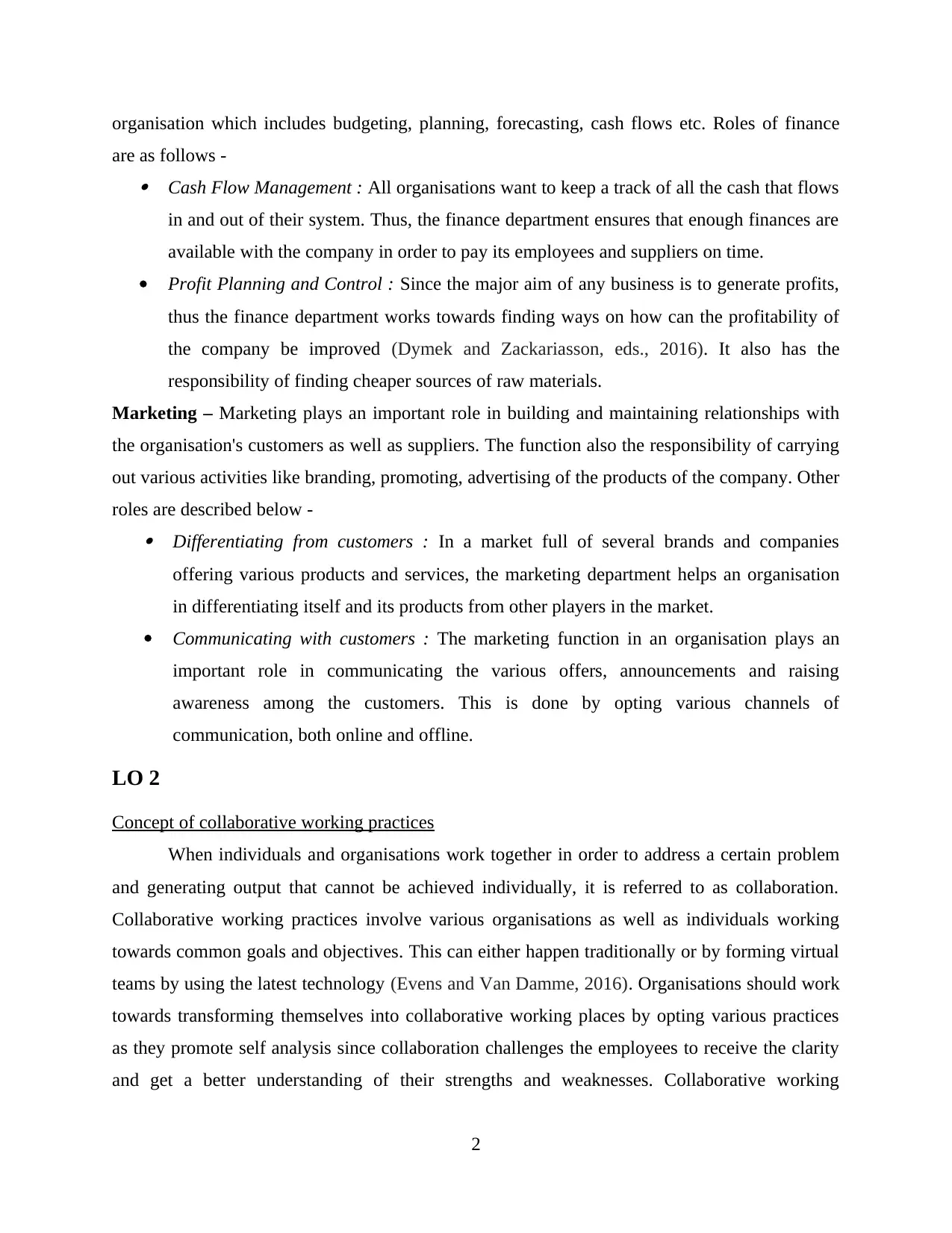
organisation which includes budgeting, planning, forecasting, cash flows etc. Roles of finance
are as follows - Cash Flow Management : All organisations want to keep a track of all the cash that flows
in and out of their system. Thus, the finance department ensures that enough finances are
available with the company in order to pay its employees and suppliers on time.
Profit Planning and Control : Since the major aim of any business is to generate profits,
thus the finance department works towards finding ways on how can the profitability of
the company be improved (Dymek and Zackariasson, eds., 2016). It also has the
responsibility of finding cheaper sources of raw materials.
Marketing – Marketing plays an important role in building and maintaining relationships with
the organisation's customers as well as suppliers. The function also the responsibility of carrying
out various activities like branding, promoting, advertising of the products of the company. Other
roles are described below - Differentiating from customers : In a market full of several brands and companies
offering various products and services, the marketing department helps an organisation
in differentiating itself and its products from other players in the market.
Communicating with customers : The marketing function in an organisation plays an
important role in communicating the various offers, announcements and raising
awareness among the customers. This is done by opting various channels of
communication, both online and offline.
LO 2
Concept of collaborative working practices
When individuals and organisations work together in order to address a certain problem
and generating output that cannot be achieved individually, it is referred to as collaboration.
Collaborative working practices involve various organisations as well as individuals working
towards common goals and objectives. This can either happen traditionally or by forming virtual
teams by using the latest technology (Evens and Van Damme, 2016). Organisations should work
towards transforming themselves into collaborative working places by opting various practices
as they promote self analysis since collaboration challenges the employees to receive the clarity
and get a better understanding of their strengths and weaknesses. Collaborative working
2
are as follows - Cash Flow Management : All organisations want to keep a track of all the cash that flows
in and out of their system. Thus, the finance department ensures that enough finances are
available with the company in order to pay its employees and suppliers on time.
Profit Planning and Control : Since the major aim of any business is to generate profits,
thus the finance department works towards finding ways on how can the profitability of
the company be improved (Dymek and Zackariasson, eds., 2016). It also has the
responsibility of finding cheaper sources of raw materials.
Marketing – Marketing plays an important role in building and maintaining relationships with
the organisation's customers as well as suppliers. The function also the responsibility of carrying
out various activities like branding, promoting, advertising of the products of the company. Other
roles are described below - Differentiating from customers : In a market full of several brands and companies
offering various products and services, the marketing department helps an organisation
in differentiating itself and its products from other players in the market.
Communicating with customers : The marketing function in an organisation plays an
important role in communicating the various offers, announcements and raising
awareness among the customers. This is done by opting various channels of
communication, both online and offline.
LO 2
Concept of collaborative working practices
When individuals and organisations work together in order to address a certain problem
and generating output that cannot be achieved individually, it is referred to as collaboration.
Collaborative working practices involve various organisations as well as individuals working
towards common goals and objectives. This can either happen traditionally or by forming virtual
teams by using the latest technology (Evens and Van Damme, 2016). Organisations should work
towards transforming themselves into collaborative working places by opting various practices
as they promote self analysis since collaboration challenges the employees to receive the clarity
and get a better understanding of their strengths and weaknesses. Collaborative working
2
Paraphrase This Document
Need a fresh take? Get an instant paraphrase of this document with our AI Paraphraser
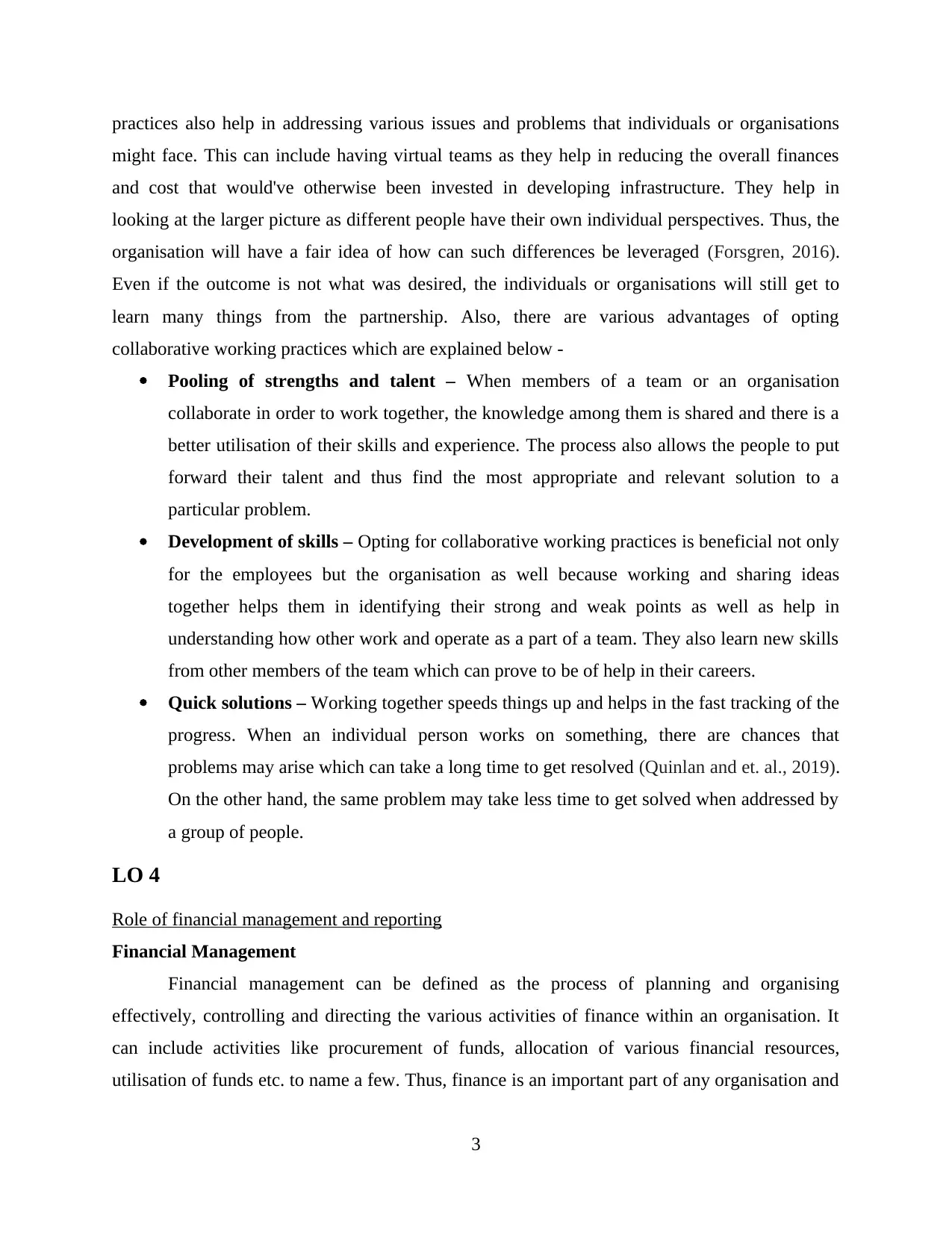
practices also help in addressing various issues and problems that individuals or organisations
might face. This can include having virtual teams as they help in reducing the overall finances
and cost that would've otherwise been invested in developing infrastructure. They help in
looking at the larger picture as different people have their own individual perspectives. Thus, the
organisation will have a fair idea of how can such differences be leveraged (Forsgren, 2016).
Even if the outcome is not what was desired, the individuals or organisations will still get to
learn many things from the partnership. Also, there are various advantages of opting
collaborative working practices which are explained below -
Pooling of strengths and talent – When members of a team or an organisation
collaborate in order to work together, the knowledge among them is shared and there is a
better utilisation of their skills and experience. The process also allows the people to put
forward their talent and thus find the most appropriate and relevant solution to a
particular problem.
Development of skills – Opting for collaborative working practices is beneficial not only
for the employees but the organisation as well because working and sharing ideas
together helps them in identifying their strong and weak points as well as help in
understanding how other work and operate as a part of a team. They also learn new skills
from other members of the team which can prove to be of help in their careers.
Quick solutions – Working together speeds things up and helps in the fast tracking of the
progress. When an individual person works on something, there are chances that
problems may arise which can take a long time to get resolved (Quinlan and et. al., 2019).
On the other hand, the same problem may take less time to get solved when addressed by
a group of people.
LO 4
Role of financial management and reporting
Financial Management
Financial management can be defined as the process of planning and organising
effectively, controlling and directing the various activities of finance within an organisation. It
can include activities like procurement of funds, allocation of various financial resources,
utilisation of funds etc. to name a few. Thus, finance is an important part of any organisation and
3
might face. This can include having virtual teams as they help in reducing the overall finances
and cost that would've otherwise been invested in developing infrastructure. They help in
looking at the larger picture as different people have their own individual perspectives. Thus, the
organisation will have a fair idea of how can such differences be leveraged (Forsgren, 2016).
Even if the outcome is not what was desired, the individuals or organisations will still get to
learn many things from the partnership. Also, there are various advantages of opting
collaborative working practices which are explained below -
Pooling of strengths and talent – When members of a team or an organisation
collaborate in order to work together, the knowledge among them is shared and there is a
better utilisation of their skills and experience. The process also allows the people to put
forward their talent and thus find the most appropriate and relevant solution to a
particular problem.
Development of skills – Opting for collaborative working practices is beneficial not only
for the employees but the organisation as well because working and sharing ideas
together helps them in identifying their strong and weak points as well as help in
understanding how other work and operate as a part of a team. They also learn new skills
from other members of the team which can prove to be of help in their careers.
Quick solutions – Working together speeds things up and helps in the fast tracking of the
progress. When an individual person works on something, there are chances that
problems may arise which can take a long time to get resolved (Quinlan and et. al., 2019).
On the other hand, the same problem may take less time to get solved when addressed by
a group of people.
LO 4
Role of financial management and reporting
Financial Management
Financial management can be defined as the process of planning and organising
effectively, controlling and directing the various activities of finance within an organisation. It
can include activities like procurement of funds, allocation of various financial resources,
utilisation of funds etc. to name a few. Thus, finance is an important part of any organisation and
3
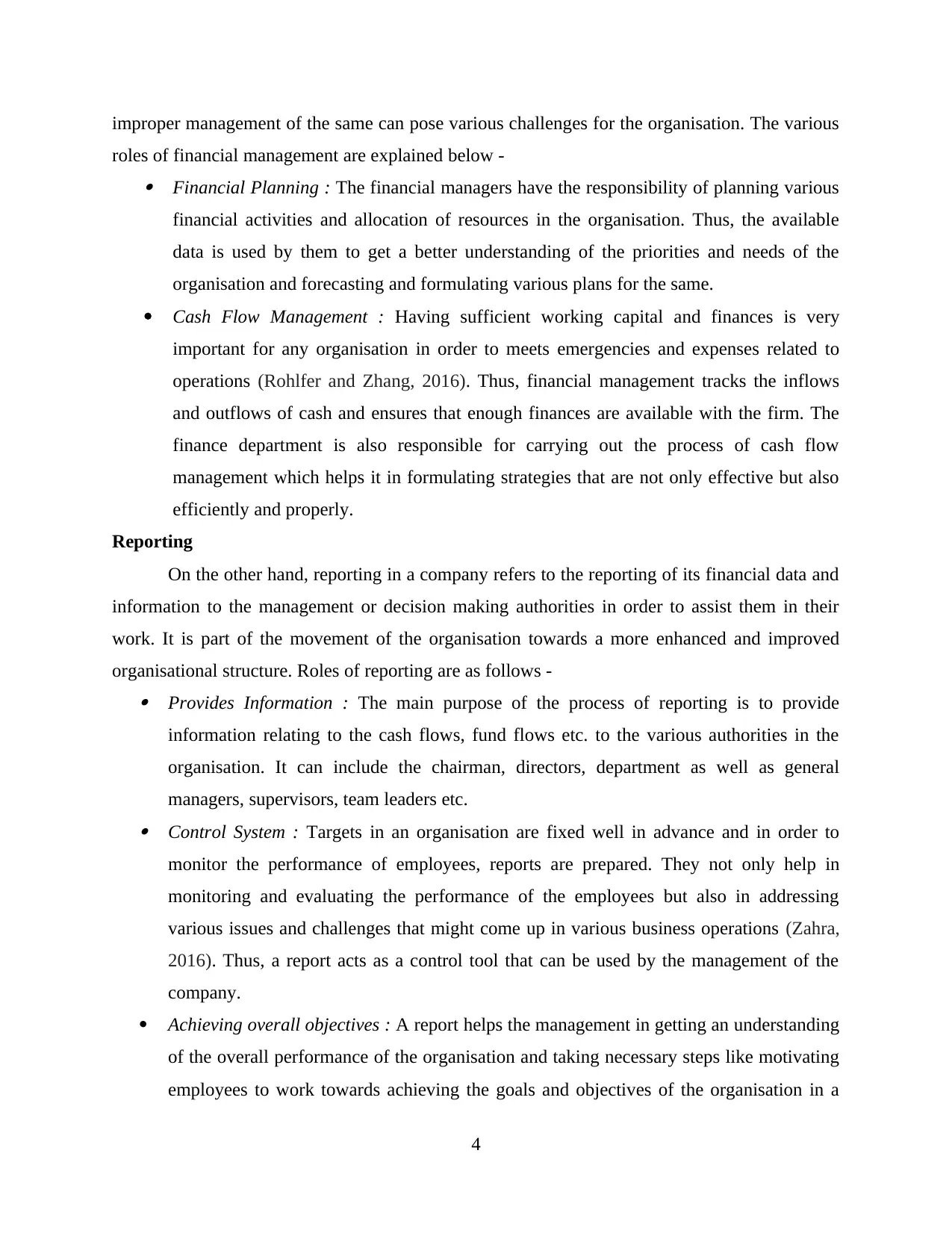
improper management of the same can pose various challenges for the organisation. The various
roles of financial management are explained below - Financial Planning : The financial managers have the responsibility of planning various
financial activities and allocation of resources in the organisation. Thus, the available
data is used by them to get a better understanding of the priorities and needs of the
organisation and forecasting and formulating various plans for the same.
Cash Flow Management : Having sufficient working capital and finances is very
important for any organisation in order to meets emergencies and expenses related to
operations (Rohlfer and Zhang, 2016). Thus, financial management tracks the inflows
and outflows of cash and ensures that enough finances are available with the firm. The
finance department is also responsible for carrying out the process of cash flow
management which helps it in formulating strategies that are not only effective but also
efficiently and properly.
Reporting
On the other hand, reporting in a company refers to the reporting of its financial data and
information to the management or decision making authorities in order to assist them in their
work. It is part of the movement of the organisation towards a more enhanced and improved
organisational structure. Roles of reporting are as follows - Provides Information : The main purpose of the process of reporting is to provide
information relating to the cash flows, fund flows etc. to the various authorities in the
organisation. It can include the chairman, directors, department as well as general
managers, supervisors, team leaders etc. Control System : Targets in an organisation are fixed well in advance and in order to
monitor the performance of employees, reports are prepared. They not only help in
monitoring and evaluating the performance of the employees but also in addressing
various issues and challenges that might come up in various business operations (Zahra,
2016). Thus, a report acts as a control tool that can be used by the management of the
company.
Achieving overall objectives : A report helps the management in getting an understanding
of the overall performance of the organisation and taking necessary steps like motivating
employees to work towards achieving the goals and objectives of the organisation in a
4
roles of financial management are explained below - Financial Planning : The financial managers have the responsibility of planning various
financial activities and allocation of resources in the organisation. Thus, the available
data is used by them to get a better understanding of the priorities and needs of the
organisation and forecasting and formulating various plans for the same.
Cash Flow Management : Having sufficient working capital and finances is very
important for any organisation in order to meets emergencies and expenses related to
operations (Rohlfer and Zhang, 2016). Thus, financial management tracks the inflows
and outflows of cash and ensures that enough finances are available with the firm. The
finance department is also responsible for carrying out the process of cash flow
management which helps it in formulating strategies that are not only effective but also
efficiently and properly.
Reporting
On the other hand, reporting in a company refers to the reporting of its financial data and
information to the management or decision making authorities in order to assist them in their
work. It is part of the movement of the organisation towards a more enhanced and improved
organisational structure. Roles of reporting are as follows - Provides Information : The main purpose of the process of reporting is to provide
information relating to the cash flows, fund flows etc. to the various authorities in the
organisation. It can include the chairman, directors, department as well as general
managers, supervisors, team leaders etc. Control System : Targets in an organisation are fixed well in advance and in order to
monitor the performance of employees, reports are prepared. They not only help in
monitoring and evaluating the performance of the employees but also in addressing
various issues and challenges that might come up in various business operations (Zahra,
2016). Thus, a report acts as a control tool that can be used by the management of the
company.
Achieving overall objectives : A report helps the management in getting an understanding
of the overall performance of the organisation and taking necessary steps like motivating
employees to work towards achieving the goals and objectives of the organisation in a
4
⊘ This is a preview!⊘
Do you want full access?
Subscribe today to unlock all pages.

Trusted by 1+ million students worldwide
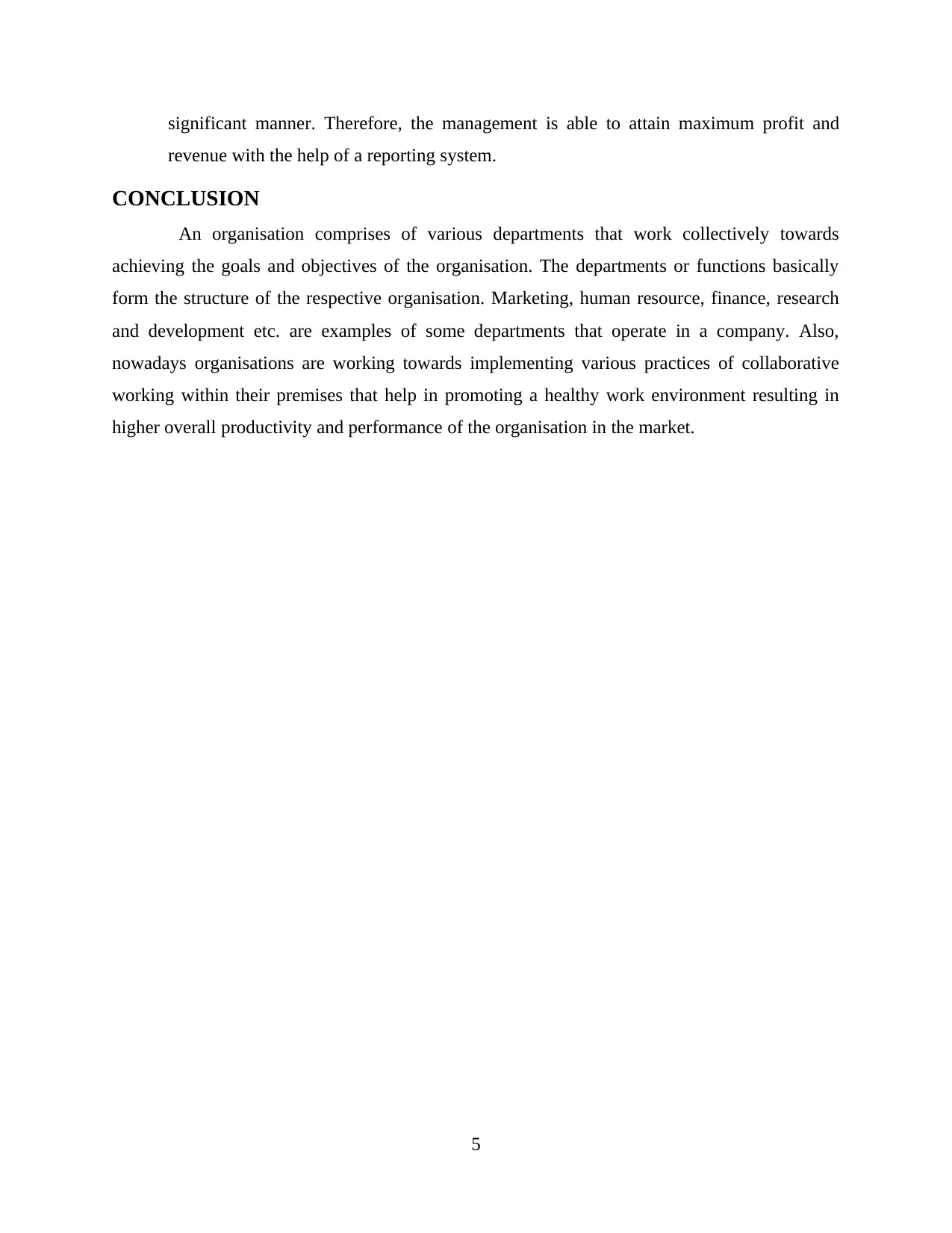
significant manner. Therefore, the management is able to attain maximum profit and
revenue with the help of a reporting system.
CONCLUSION
An organisation comprises of various departments that work collectively towards
achieving the goals and objectives of the organisation. The departments or functions basically
form the structure of the respective organisation. Marketing, human resource, finance, research
and development etc. are examples of some departments that operate in a company. Also,
nowadays organisations are working towards implementing various practices of collaborative
working within their premises that help in promoting a healthy work environment resulting in
higher overall productivity and performance of the organisation in the market.
5
revenue with the help of a reporting system.
CONCLUSION
An organisation comprises of various departments that work collectively towards
achieving the goals and objectives of the organisation. The departments or functions basically
form the structure of the respective organisation. Marketing, human resource, finance, research
and development etc. are examples of some departments that operate in a company. Also,
nowadays organisations are working towards implementing various practices of collaborative
working within their premises that help in promoting a healthy work environment resulting in
higher overall productivity and performance of the organisation in the market.
5
Paraphrase This Document
Need a fresh take? Get an instant paraphrase of this document with our AI Paraphraser
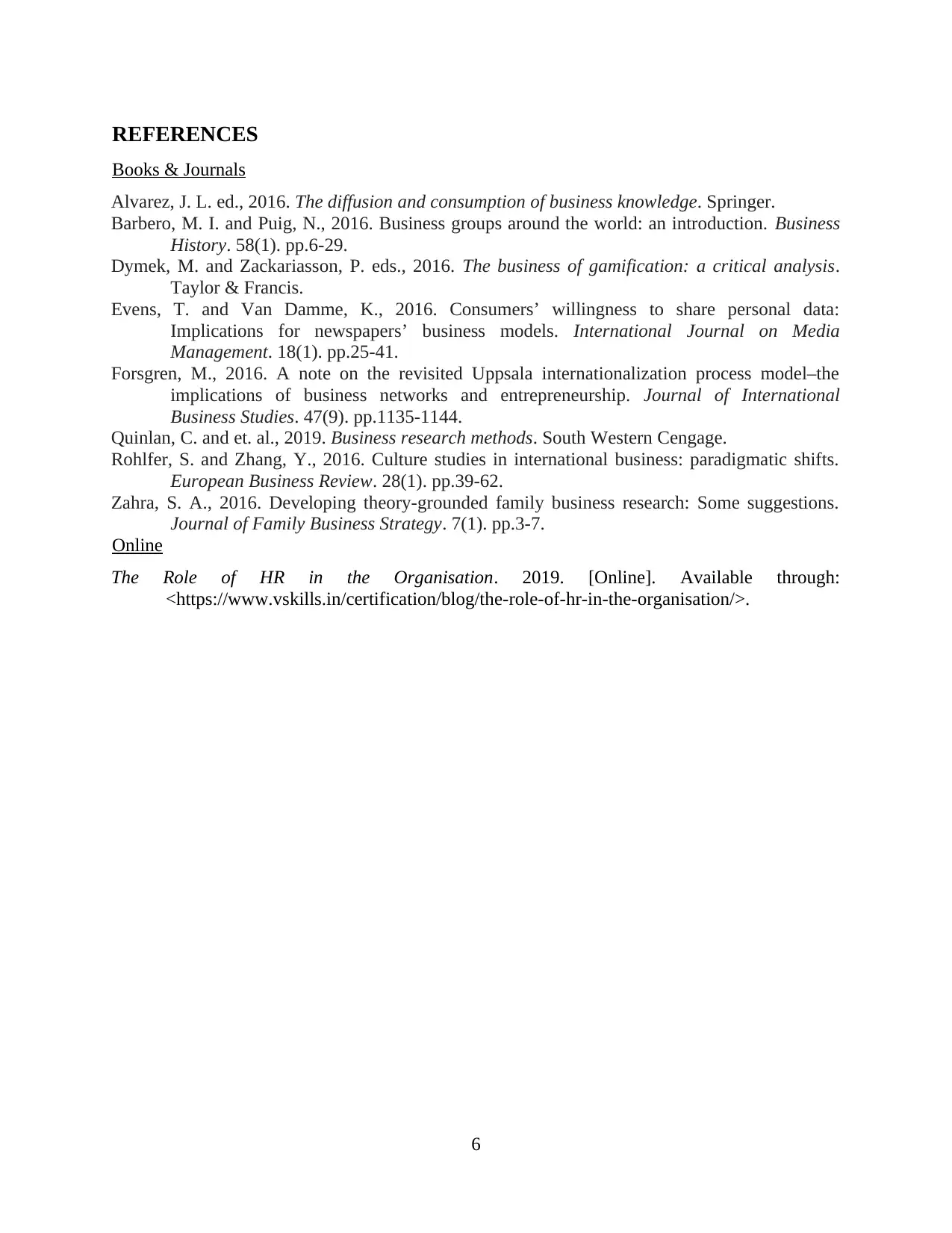
REFERENCES
Books & Journals
Alvarez, J. L. ed., 2016. The diffusion and consumption of business knowledge. Springer.
Barbero, M. I. and Puig, N., 2016. Business groups around the world: an introduction. Business
History. 58(1). pp.6-29.
Dymek, M. and Zackariasson, P. eds., 2016. The business of gamification: a critical analysis.
Taylor & Francis.
Evens, T. and Van Damme, K., 2016. Consumers’ willingness to share personal data:
Implications for newspapers’ business models. International Journal on Media
Management. 18(1). pp.25-41.
Forsgren, M., 2016. A note on the revisited Uppsala internationalization process model–the
implications of business networks and entrepreneurship. Journal of International
Business Studies. 47(9). pp.1135-1144.
Quinlan, C. and et. al., 2019. Business research methods. South Western Cengage.
Rohlfer, S. and Zhang, Y., 2016. Culture studies in international business: paradigmatic shifts.
European Business Review. 28(1). pp.39-62.
Zahra, S. A., 2016. Developing theory-grounded family business research: Some suggestions.
Journal of Family Business Strategy. 7(1). pp.3-7.
Online
The Role of HR in the Organisation. 2019. [Online]. Available through:
<https://www.vskills.in/certification/blog/the-role-of-hr-in-the-organisation/>.
6
Books & Journals
Alvarez, J. L. ed., 2016. The diffusion and consumption of business knowledge. Springer.
Barbero, M. I. and Puig, N., 2016. Business groups around the world: an introduction. Business
History. 58(1). pp.6-29.
Dymek, M. and Zackariasson, P. eds., 2016. The business of gamification: a critical analysis.
Taylor & Francis.
Evens, T. and Van Damme, K., 2016. Consumers’ willingness to share personal data:
Implications for newspapers’ business models. International Journal on Media
Management. 18(1). pp.25-41.
Forsgren, M., 2016. A note on the revisited Uppsala internationalization process model–the
implications of business networks and entrepreneurship. Journal of International
Business Studies. 47(9). pp.1135-1144.
Quinlan, C. and et. al., 2019. Business research methods. South Western Cengage.
Rohlfer, S. and Zhang, Y., 2016. Culture studies in international business: paradigmatic shifts.
European Business Review. 28(1). pp.39-62.
Zahra, S. A., 2016. Developing theory-grounded family business research: Some suggestions.
Journal of Family Business Strategy. 7(1). pp.3-7.
Online
The Role of HR in the Organisation. 2019. [Online]. Available through:
<https://www.vskills.in/certification/blog/the-role-of-hr-in-the-organisation/>.
6
1 out of 8
Related Documents
Your All-in-One AI-Powered Toolkit for Academic Success.
+13062052269
info@desklib.com
Available 24*7 on WhatsApp / Email
![[object Object]](/_next/static/media/star-bottom.7253800d.svg)
Unlock your academic potential
Copyright © 2020–2025 A2Z Services. All Rights Reserved. Developed and managed by ZUCOL.





